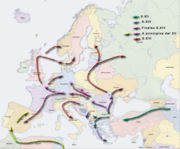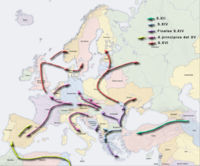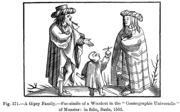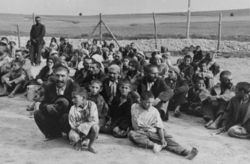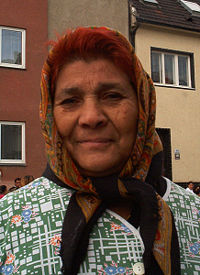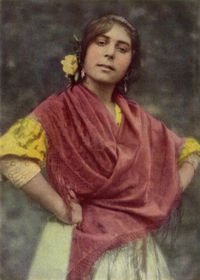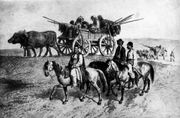Roma people
2008/9 Schools Wikipedia Selection. Related subjects: Peoples
| Roma | |||||||||||||||||||||||||||||||||||||||||||||||||||||||||||||||||||||
|---|---|---|---|---|---|---|---|---|---|---|---|---|---|---|---|---|---|---|---|---|---|---|---|---|---|---|---|---|---|---|---|---|---|---|---|---|---|---|---|---|---|---|---|---|---|---|---|---|---|---|---|---|---|---|---|---|---|---|---|---|---|---|---|---|---|---|---|---|---|
 |
|||||||||||||||||||||||||||||||||||||||||||||||||||||||||||||||||||||
| Flag of the Roma people | |||||||||||||||||||||||||||||||||||||||||||||||||||||||||||||||||||||
| Total population | |||||||||||||||||||||||||||||||||||||||||||||||||||||||||||||||||||||
|
15 million or more |
|||||||||||||||||||||||||||||||||||||||||||||||||||||||||||||||||||||
| Regions with significant populations | |||||||||||||||||||||||||||||||||||||||||||||||||||||||||||||||||||||
|
|||||||||||||||||||||||||||||||||||||||||||||||||||||||||||||||||||||
| Languages | |||||||||||||||||||||||||||||||||||||||||||||||||||||||||||||||||||||
| Romany, languages of native region | |||||||||||||||||||||||||||||||||||||||||||||||||||||||||||||||||||||
| Religions | |||||||||||||||||||||||||||||||||||||||||||||||||||||||||||||||||||||
| Romanipen, combined with assimilations from local religions | |||||||||||||||||||||||||||||||||||||||||||||||||||||||||||||||||||||
| Related ethnic groups | |||||||||||||||||||||||||||||||||||||||||||||||||||||||||||||||||||||
| South Asians ( Desi) |
The Roma (as a noun, singular Rom, plural Roma; sometimes Rrom, Rroma, Rromany people, Romany people, Romani people or Romanies) belong to many ethnic groups that appear in literature and folklore, and are often referred to as Gypsies or Gipsies. The Roma have their origins in India and are thus originally Hindu.
The Roma are still thought of as wandering nomads in the popular imagination, despite the fact that today the vast majority live in permanent housing. This widely dispersed ethnic group lives across the world not only near Southern and Eastern Europe, but also in the American continent and the Middle East.
Population
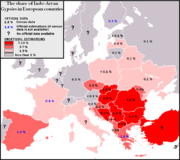
Worldwide there is an estimated population of at least 15 million Roma. The official number of Roma people is disputed in many countries. Because many Roma often refuse to register their ethnic identity in official censuses for fear of discrimination, unofficial estimates are undertaken in efforts to reveal their true numbers. The largest population of Roma is found in the Balkan peninsula; significant numbers also live in the Americas, the former Soviet Union, Western Europe, the Middle East, and North Africa.
The Roma recognize divisions among themselves based in part on territorial, cultural and dialectal differences. Some authorities recognize five main groups:
- Kalderash (also Kotlar(i) or Căldărari) are the most numerous, traditionally cauldron-making coppersmiths, from the Balkans, many of whom migrated to central Europe and North America;
- Gitanos or Ciganos (also Calé or Calones) mostly in the Iberian Peninsula, North Africa, and southern France; associated with entertainment;
- Sinti (also Sinta), known in German and Dutch as Zigeuner and in Italian as Zingari, mostly in Alsace and other regions of France and Germany (Other experts, and Sinti themselves, insist that Sinti are not a subgroup of Roma but rather a separate ethnic group which also had Indian origins and a history of nomadism);
- Romnichal (also Romanichal or Rom'nies) mainly in Britain and North America; and
- Erlides (also Yerlii or Arli) settled in southeastern Europe and Turkey.
Some groups, like the Finnish Roma population (Kaalee) and the Norwegian and Swedish Travellers, are hard to categorize. Each of these main divisions may be further divided into two or more subgroups distinguished by occupational specialization, territorial origin, or both. Some of these group names are Bashaldé; Churari; Luri; Ungaritza; Lovari ( Lovara) from Hungary; Lyuli (Jughi, Multani, Luli, Mug(h)at) from Central Asia; Machvaya (Machavaya, Machwaya, or Macwaia) from Serbia; Romungro ( Modyar or Modgar) from Hungary and neighbouring carpathian countries; Xoraxai ( Horahane) from Greece/Turkey; Boyash (Lingurari, Ludar, Ludari, Rudari, or Zlătari) from Romanian/Moldovan miners; Ursari from Romanian/Moldovan bear-trainers; Argintari from silversmiths; Aurari from goldsmiths; Florari from florists;, and Lăutari from singers.
Origins
The absence of a written history has meant that the origin and early history of the Roma people was long an enigma. As early as 200 years ago, cultural anthropologists hypothesised an Indian origin of the Roma based on linguistic evidence. Genetic information confirms this.
Although the Nazis claimed that the Gypsies were not Aryan, some members of the Gypsy Lore Society (established in 1888 in England) claimed that the Gypsies were the most ancient Aryans and "sought to protect them from mixing with non-Gypsy elements and from modernization...".
The Roma are believed to have originated from Multan, located in the Punjab and Rajasthan regions of the Indian subcontinent. The forefathers of the Roma were essentially in the service of the Katasraj group of temples dedicated to Lord Narasimha, an Avatar of Lord Vishnu which, during the 11th century, was known for its wealth. Gold, silver, diamonds and pearls donated by rich Hindu kings and merchants to the temple made it the richest temple of that period. The temple had to be protected by a large Kshatriya force of Jatt- Rajputs- Khsatris.
Following ancient Hindu traditions, such temples, governed by complex laws and rituals, were a massive commercial enterprise. They employed around ten thousand people directly, as priests, staff members performing various ancillary duties (e.g. housekeeping of temples, cooking for 50,000 people comprising pilgrims, priests, temple guards and other staff members), and maintenance staff. Such temple complexes, having annual budgets running into the equivalent of several million dollars today, were flourishing business economies unto themselves, giving rise to job opportunities and trade.
These temples patronised musicians and dancers, often exceeding 2000 in number. Roma music traces its origin from these musicians in the Katasraj Temple whose way of worshipping Lord Narasimha was by performing music in his court. The wealth of the Katasraj temple at Multan attracted Mahmud of Ghazni from present-day Afghanistan who was able, after many failed attempts, to lay his hands on this temple's wealth.
Roma began their migration to Europe and North Africa via the Iranian plateau, some joining the victor's army, others in an attempt to retrieve their honour, while many were taken into slavery. The migration took place in waves between the 9th and 14th centuries. In the course of their dispersion, the Roma lost their original Hindu identity and adopted the culture and religion of their host country. The original Multani dialect, a colloquial mixture of the Punjabi and Sanskrit languages, has many words which are common to Romani dialects spoken by their descendants more than 40 generations later.
Linguistic evidence
Until the mid to late eighteenth century, theories of the origin of the Romani were mostly speculative. Then in 1782, Johann Christian Christoph Rüdiger published his research that pointed out the relationship between the Romani language and Hindustani. Subsequent work supported the hypothesis that Romani shared a common origin with the Indo-Aryan languages of Northern India, with Romani grouping most closely with Sinhalese in a recent study.
The majority of historians accepted this as evidence of an Indian origin for the Romani, but some maintained that the Romani acquired the language through contact with Indian merchants.
Genetic evidence
Further evidence for the Indian origin of the Roma came in the late 1990s when it was discovered that Roma populations carried large frequencies of particular Y chromosomes (inherited paternally) and mitochondrial DNA (inherited maternally) that otherwise exist only in populations from South Asia.
47.3% of Roma men carry Y chromosomes of haplogroup H-M82 which is otherwise rare outside of the Indian subcontinent. Mitochondrial haplogroup M, most common in Indian subjects and rare outside Southern Asia, accounts for nearly 30% of Roma people. A more detailed study of Polish Roma shows this to be of the M5 lineage, which is specific to India. Moreover, a form of the inherited disorder congenital myasthenia is carried by around 4% of the Roma population. This form of the disorder, caused by the 1267delG mutation, is otherwise only known in subjects of Indian ancestry.
This is considered unambiguous proof that all Roma are descended from a single founding population, originating from the Indian subcontinent around 40 generations ago, which subsequently split into the subgroups we see today.
History
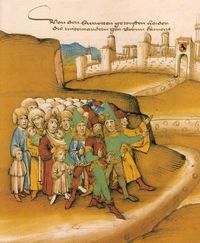
Linguistic and genetic evidence indicates the Roma originated from the Indian subcontinent. The cause of the Roma diaspora is unknown. However, the most probable conclusion is that the Roma were part of the military in Northern India. When there were repeated raids by Mahmud of Ghazni and these soldiers were defeated, they were moved west with their families into the Byzantine Empire. This occurred between 1000 and 1050 CE. This departure date is assumed because, linguistically speaking, the Romany language is a New Indo-Aryan language (NIA)--it has only two genders (masculine and feminine). Until around the year 1000, the Indo-Aryan languages, named Middle Indo-Aryan (MIA), had three genders (masculine, feminine and neuter). By the turn of the 2nd millennium they changed into the NIA phase, losing the neuter gender. Most of the neuter nouns became masculine while a few feminine, like the neuter अग्नि (agni) in the Prakrit became the feminine आग (āg) in Hindi and Jag in Romany. The parallels in grammatical gender evolution between Romany and other NIA languages is proposed to prove that the change occurred in the Indian subcontinent. It is therefore not considered possible that the Romas' ancestors left India prior to 1000 CE. They then stayed in the Byzantine Empire for several hundred years. However, the Muslim expansion, mainly made by the Seljuk Turks, into the Byzantine Empire recommenced the movement of the Roma people.
The Banjara people, numbering around 2,274,000 in India, are Gypsies, who claim that they, too, are descended from the Rajputs, and that many of their ancestors, left India through the Himalayas and never returned. For this reason, the Banjara are considered related to the Romani people. Many historians believe that the Muslim conquerors of northern India took the Roma as slaves and marched them home over the unforgiving terrain of Central Asia, taking great tolls on the population and thereby giving rise to such designations as the Hindu Kush mountains of present-day Pakistan and Afghanistan. Mahmud of Ghazni reportedly took 500,000 prisoners during a Turkish/Persian invasion of Sindh and Punjab.
Others suggest the Roma were originally low- caste Hindus recruited into an army of mercenaries, granted warrior caste status, and sent westward to resist Islamic military expansion. In either case, upon arrival, they became a distinct community. Why the Roma did not return to India, choosing instead to travel west into Europe, is an enigma, but may relate to military service under the Muslims.
Contemporary scholars have suggested that one of the first written references to the Roma, under the term "Atsinganoi", ( Greek), dates from the Byzantine era during a time of famine in the 9th century. In 800 CE, Saint Athanasia gave food to "foreigners called the Atsinganoi" near Thrace. Later, in 803 CE, Theophanes the Confessor wrote that Emperor Nikephoros I had the help of the "Atsinganoi" to put down a riot with their "knowledge of magic".
"Atsingani" was used to refer to itinerant fortune tellers, ventriloquists and wizards who visited the Emperor Constantine IX in the year 1054. The hagiographical text, The Life of St. George the Anchorite, mentions that the "Atsingani" were called on by Constantine to help rid his forests of the wild animals which were killing his livestock. They are later described as sorcerers and evildoers and accused of trying to poison the Emperor's favorite hound.
In 1322 CE a Franciscan monk named Simon Simeonis described people resembling these "atsinganoi" living in Crete and in 1350 CE Ludolphus of Sudheim mentioned a similar people with a unique language whom he called Mandapolos, a word which some theorize was possibly derived from the Greek word mantes (meaning prophet or fortune teller).
Around 1360, an independent Romani fiefdom (called the Feudum Acinganorum) was established in Corfu and became "a settled community and an important and established part of the economy."
By the 14th century, the Roma had reached the Balkans; by 1424 CE, Germany; and by the 16th century, Scotland and Sweden. Some Roma migrated from Persia through North Africa, reaching Europe via Spain in the 15th century. The two currents met in France. Roma began immigrating to the United States in colonial times, with small groups in Virginia and French Louisiana. Larger-scale immigration began in the 1860s, with groups of Romnichal from Britain. The largest number immigrated in the early 1900s, mainly from the Vlax group of Kalderash. Many Roma also settled in Latin America.
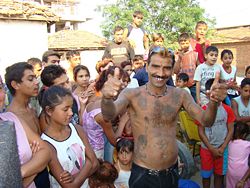
When the Roma people arrived in Europe, curiosity was soon followed by hostility and xenophobia. Roma were enslaved for five centuries in Wallachia and Moldavia until abolition in 1864. Elsewhere in Europe, they were subject to ethnic cleansing, abduction of their children, and forced labor. During World War II, the Nazis murdered 200,000 to 800,000 Roma in an attempted genocide known as the Porajmos. They were marked for extermination and sentenced to forced labor and imprisonment in concentration camps. They were often killed on sight, especially by the Einsatzgruppen (essentially mobile killing units) on the Eastern Front.
In Communist Eastern Europe, Roma experienced assimilation schemes and restrictions of cultural freedom. The Romany language and Romani music were banned from public performance in Bulgaria. In Czechoslovakia, they were labeled a "socially degraded stratum," and Roma women were sterilized as part of a state policy to reduce their population. This policy was implemented with large financial incentives, threats of denying future social welfare payments, misinformation or after administering drugs (Silverman 1995; Helsinki Watch 1991). An official inquiry from the Czech Republic, resulting in a report (December 2005), concluded that the Communist authorities had practised an assimilation policy towards Roma, which "included efforts by social services to control the birth rate in the Romani community" and that "the problem of sexual sterilisation carried out in the Czech Republic, either with improper motivation or illegally, exists" , with new revealed cases up until 2004, in both the Czech Republic and Slovakia.
In the early 1990s, Germany deported tens of thousands of illegal immigrants to Eastern Europe. Sixty percent of some 100,000 Romanian nationals deported under a 1992 treaty were Roma. In Norway, many Roma were forcibly sterilized by the state until 1977.
Society and culture
The traditional Roma place a high value on the extended family. Virginity is essential in unmarried women. Both men and women often marry young; there has been controversy in several countries over the Roma practice of child marriage. Roma law establishes that the man’s family must pay a dowry to the bride's parents, but only traditional families still follow this rule.
Once married, the woman joins the husband's family where her main job is to tend to her husband's and her children's needs, and to take care of the in-laws as well. The power structure in the traditional Roma household has at its top the oldest man or grandfather, and men in general have more authority than women. As women get older, however, they gain respect and authority in the eyes of the community. Young wives begin gaining authority once they mother children.
Roma social behaviour is strictly regulated by Hindu purity laws ("marime" or "marhime"), still respected by most Roma and among Sinti groups by the older generations. This regulation affects many aspects of life, and is applied to actions, people and things: parts of the human body are considered impure: the genital organs (because they produce emissions) as well as the rest of the lower body. Fingernails and toenails must be filed with an emery board, as cutting them with a clipper is a taboo. Clothes for the lower body, as well as the clothes of menstruating women, are washed separately. Items used for eating are also washed in a different place. Childbirth is considered impure, and must occur outside the dwelling place. The mother is considered impure for forty days after giving birth. Death is considered impure, and affects the whole family of the dead, who remain impure for a period of time. However, in contrast to the practice of cremating the dead, Roma dead must be buried. It is possible that this tradition was adapted from Abrahamic religions after the Roma left the Indian subcontinent. Some animals are also considered impure, for instance cats because they lick themselves and mix the impure outside with their pure inside.
Religion
Roma have usually adopted the dominant religion of the host country while often preserving aspects of their particular belief systems and indigenous religion and worship. Most Eastern European Roma are Catholic, Orthodox Christian or Muslim. Those in western Europe and the United States are mostly Roman Catholic or Protestant. In Turkey, Egypt, and the southern Balkans, the Roma are split into Christian and Muslim populations.
Evangelical Romany churches exist today in every country where Roma are settled. The movement is particularly strong in France and Spain; there are more than one thousand Roma churches (known as "Filadelfia") in Spain, with almost one hundred in Madrid alone. In Germany, the most numerous group is that of Polish Roma, having their main church in Mannheim. Other important and numerous Romany assemblies exist in Los Angeles, California; Houston, Texas; Buenos Aires, Argentina; and Mexico City. Some groups in Romania and Chile have joined the Seventh-day Adventist Church.
In the Balkans, the Roma of the Republic of Macedonia, Kosovo and Albania have been particularly active in Islamic mystical brotherhoods ( Sufism). Muslim Roma immigrants to western Europe and America have brought these traditions with them.
Music
Roma music plays an important role in Eastern European countries such as Croatia, Serbia, Montenegro, the Republic of Macedonia, Albania, Hungary, Russia, and Romania, and the style and performance practices of Roma musicians have influenced European classical composers such as Franz Liszt and Johannes Brahms. The lăutari who perform at traditional Romanian weddings are virtually all Roma. Probably the most internationally prominent contemporary performers in the lăutar tradition are Taraful Haiducilor. Bulgaria's popular "wedding music," too, is almost exclusively performed by Roma musicians such as Ivo Papasov, a virtuoso clarinetist closely associated with this genre. Many famous classical musicians, such as the Hungarian pianist Georges Cziffra, are Roma, as are many prominent performers of manele. Zdob şi Zdub, one of the most prominent rock bands in Moldova, although not Roma themselves, draw heavily on Roma music, as do Spitalul de Urgenţă in Romania, Goran Bregović in Serbia, Darko Rundek in Croatia, Beirut and Gogol Bordello in the United States.
Another tradition of Roma music is the genre of the Gypsy brass band, with such notable practitioners as Boban Marković of Serbia, and the brass lăutari groups Fanfare Ciocărlia and Fanfare din Cozmesti of Romania.
The distinctive sound of Roma music has also strongly influenced bolero, jazz, and flamenco (especially cante jondo) in Europe. European-style Gypsy jazz is still widely practised among the original creators (the Roma People); one who acknowledged this artistic debt was guitarist Django Reinhardt. Contemporary artists in this tradition known internationally include Stochelo Rosenberg, Biréli Lagrène, Jimmy Rosenberg, and Tchavolo Schmitt.
The Roma of Turkey have achieved musical acclaim from national and local audiences. Local performers usually perform for special holidays. Their music is usually performed on instruments such as the darbuka and gırnata. A number of nationwide best seller performers are said to be of Roma origin.
Language
Most Roma speak one of several dialects of Romany, an Indo-Aryan language. They also will often speak the languages of the countries they live in. Typically, they also incorporate loanwords and calques into Romani from the languages of those countries, especially words for terms that the Romani language does not have. The Gitanos of Spain and the Romnichal of the UK, have lost their knowledge of pure Romani, and respectively speak the patois languages Caló and Angloromany.
There are independent groups currently working toward standardizing the language, including groups in Romania, Serbia, Montenegro, the USA, and Sweden. Romany is not currently spoken in India.
Etymology
Most Roma refer to themselves as rom or rrom, depending on the dialect. The word means "husband", romni/rromni meaning "wife", while the unmarried are named čhavo ("boy") (pronounced [cʰaʋo]) or čhej ("girl"). There are no historical proofs to clarify the etymology of these words.
The word Rom (plural Roma) is a noun, Romany is an adjective, while Romanes is an adverb (meaning, roughly, "in the Romany way"). The language is called the Romany language or Romanes. In the Romany language, the adjective is created by attaching suffixes to the root that express gender and number: "Romani" (f. sing.), "Romano (m. sing.) and "Romane" (m. & f. pl.). Usually in English only the feminine singular form is used, but they may also appear in the other forms. "Romanes" is created by attaching the suffix -es, usually employed for adverbs. The use of the word Romanes in English as a noun is incorrect.
The English term Gypsy (or Gipsy) originates from the Greek word Αιγύπτοι (Aigyptoi), modern Greek γύφτοι (gyphtoi), in the erroneous belief that the Roma originated in Egypt, and were exiled as punishment for allegedly harboring the infant Jesus. If used, this exonym should also be written with capital letter, to show that it is about an ethnic group. As described in Victor Hugo's novel The Hunchback of Notre Dame, the medieval French referred to the Roma as "egyptiens". This ethnonym is not used by the Roma to describe themselves, and is often considered pejorative (as is the term "gyp", meaning "to cheat", a reference to the suspicion the Roma engendered). However, the use of "Gypsy" in English is now so pervasive that many Roma organizations use the word Gypsy in their own names. In North America, the word "Gypsy" is commonly used as a reference to lifestyle or fashion, and not to the Roma ethnicity. The Spanish term gitano and the French term gitan may have the same origin.
In much of continental Europe, Roma are known by names similar to the Hungarian cigány (pronounced [ˈtsiɡaːɲ]), German and Dutch zigeuner, Italian zingari and Russian цыганы (tsygany). Early Byzantium literature suggests that names now referring to Gypsies such as tzigane, zincali, cigány, etc., are derived from the Greek ατσίγγανοι (atsinganoi, Latin adsincani), applied to Roma during Byzantine times, or from the Greek term αθίγγανοι (athinganoi) meaning literally 'untouchables', in reference to a 9th-century heretical sect that had been accused of practising magic and fortune-telling. In modern Greek, aside from the singular term Rom (Ρομ), the terms gyphtoi ( Greek:γύφτοι) and tsinganoi ( Greek:τσιγγάνοι) are interchangeable and both are used when referring to the Roma.
Because many Roma living in France had come via Bohemia, they were also referred to as Bohémiens. This would later be adapted to describe the impoverished artistic lifestyle of Bohemianism.
Outside Europe, Roma are referred to by more varied names, such as Kowli (کولی) in Iran; Lambani, Labana Lambadi, Rabari or Banjara in India; Ghajar (غجر) or Nawar (نور') in Arabic; and tzo'anim צוענים in Hebrew (after an ancient city in Egypt and the biblical verb צען ṣā‛an, roaming).
There is no etymological connection between the name Roma (ethnicity) and the city of Rome, ancient Rome, Romania, the Romanian people or the Romanian language.
Persecutions
Historical persecution
The first and one of the most enduring persecutions against the Roma people was the enslaving of the Roma who arrived on the territory of the historical Romanian states of Wallachia and Moldavia, which lasted from the 14th century until the second half of the 19th century. Legislation decreed that all the Roma living in these states, as well as any others who would immigrate there, were slaves.
The arrival of some branches of the Roma people in Western Europe in the 15th century was precipitated by the Ottoman conquest of the Balkans. Although the Roma themselves were refugees from the conflicts in southeastern Europe, they were mistaken by the local population in the West, because of their foreign appearance, as part of the Ottoman invasion (the German Reichstags at Landau and Freiburg in 1496-1498 declared the Roma as spies of the Turks). In Western Europe, this resulted in a violent history of persecution and attempts of ethnic cleansing until the modern era. As time passed, other accusations were added against local Roma (accusations specific to this area, against non-assimilated minorities), like that of bringing the plague, usually sharing their burden together with the local Jews.
Later in the 19th century, Roma immigration was forbidden on a racial basis in areas outside Europe, mostly in the English speaking world (in 1885 the United States outlawed the entry of the Roma) and also in some Latin American states (in 1880 Argentina adopted a similar policy).
Holocaust
The persecution of the Roma reached a peak during World War II in the Porajmos, the genocide perpetrated by the Nazis during the Holocaust. In 1935, the Nuremberg laws stripped the Roma people living in Nazi Germany of their citizenship, after which they were subjected to violence, imprisonment in concentration camps and later genocide in extermination camps. The policy was extended in areas occupied by the Nazis during the war, and it was also applied by their allies, notably the Independent State of Croatia, Romania and Hungary.
Because no accurate pre-war census figures exist for the Roma, it is impossible to accurately assess the actual number of victims. Ian Hancock, director of the Program of Romani Studies at The University of Texas at Austin, proposes a figure of up to a million and a half, while an estimate of between 220,000 and 500,000 was made by the late Sybil Milton, formerly senior historian of the U.S. Holocaust Memorial Museum.. In Central Europe, the extermination in the Protectorate of Bohemia and Moravia was so thorough that the Bohemian Romany language became totally extinct.
Assimilation
In the Habsburg Monarchy under Maria Theresia (1740-1780), a series of decrees tried to force the Roma to sedentarize, removed rights to horse and wagon ownership (1754), renamed them as "New Citizens" and forced Roma boys into military service if they had no trade (1761), forced them to register with the local authorities (1767), and prohibited marriage between Roma (1773). Her successor Josef II prohibited the wearing of traditional Roma clothing and the use of the Romany language, punishable by flogging. In Spain, attempts to assimilate the Gitanos were under way as early as 1619, when Gitanos were forcibly sedentarized, the use of the Romany language was prohibited, Gitano men and women were sent to separate workhouses and their children sent to orphanages. Similar prohibitions took place in later in 1783 under King Charles III, who prohibited the nomadic lifestyle, the use of the Calo language, Romani clothing, their trade in horses and other itinerant trades. Ultimately these measures failed, as the rest of the population rejected the integration of the Gitanos.
Other examples of forced assimilation include Norway, where a law was passed in 1896 permitting the state to remove children from their parents and place them in state institutions. This resulted in some 1,500 Roma children being taken from their parents in the 20th century.
Contemporary issues
United Kingdom
In the UK, "travellers" (referring to Irish Travellers and New Age Travellers as well as Roma) became a 2005 general election issue, with the leader of the Conservative Party promising to review the Human Rights Act 1998. This law, which absorbs the European Convention on Human Rights into UK primary legislation, is seen by some to permit the granting of retrospective planning permission. Severe population pressures and the paucity of greenfield sites have led to travellers purchasing land, and setting up residential settlements very quickly, thus subverting the planning restrictions.
Travellers argued in response that thousands of retrospective planning permissions are granted in Britain in cases involving non-Roma applicants each year and that statistics showed that 90% of planning applications by Roma and travellers were initially refused by local councils, compared with a national average of 20% for other applicants, disproving claims of preferential treatment favouring Roma.
They also argued that the root of the problem was that many traditional stopping-places had been barricaded off and that legislation passed by the previous Conservative government had effectively criminalised their community, for example by removing local authorities’ responsibility to provide sites, thus leaving the travellers with no option but to purchase unregistered new sites themselves.
Denmark
In Denmark there was much controversy when the city of Helsingør decided to put all Roma students in special classes in its public schools. The classes were later abandoned after it was determined that they were discriminatory, and the Roma were put back in regular classes.
Eastern Europe
However, the practice of placing Roma students in segregated schools or classes remains widespread in countries across Central and Eastern Europe. In Hungary, Bulgaria and Romania, many Roma children have been channeled into all-Roma schools that offer inferior quality education and are sometimes in poor physical condition, or into segregated all-Roma or predominantly Roma classes within mixed schools. In Hungary and Bulgaria, many Roma children are sent to classes for pupils with learning disabilities, regardless of whether such classes are appropriate for the children in question or not. In Bulgaria, they are also sent to so-called "delinquent schools", where a variety of human rights abuses take place.
Despite the low birth rate in the country, Bulgaria's Health Ministry was considering a law aimed at lowering the birth rate of certain minority groups, particularly the Roma, due to the high mortality rate among Roma families, which are typically large. This was later abandoned due to conflict with EU law and the Bulgarian constitution.
Roma in European population centers are often accused of crimes such as pickpocketing. This is a regular justification for anti-Roma persecution. In 1899, the Nachrichtendienst in Bezug auf die Zigeuner ("Intelligence Service Regarding the Gypsies") was set up in Munich under the direction of Alfred Dillmann, cataloguing data on all Roma individuals throughout the German lands. It did not officially close down until 1970. The results were published in 1905 in Dillmann’s Zigeuner-Buch , that was used in the next years as justification for the Porajmos. It described the Roma people as a "plague" and a "menace", but presented as Gypsy crime almost exclusively trespassing and the theft of food. A UN study found that Roma in Eastern European countries such as Bulgaria are arrested for robbery at a much higher rate than other groups. Amnesty International and Roma groups such as the Union Romani blame widespread police and government racism and persecution.
United States
Law enforcement agencies in the United States hold regular conferences on the Roma and similar nomadic groups. It is common to refer to the operators of certain types of travelling con artists and fortune-telling businesses as "Gypsies," although many are Irish Travellers or not members of any particular nomadic ethnic group.
Roma people by geographic area
Central and Eastern Europe
A significant proportion of the world's Roma live in Central and Eastern Europe, often in squatter communities with very high unemployment, while only some are fully integrated in the society. However, in some cases—notably the Kalderash clan in Romania, who work as traditional coppersmiths—they have prospered. Some Roma families choose to immigrate to Western Europe now that many of the former Communist countries like the Czech Republic, Slovakia, Romania, Hungary and Bulgaria have entered the European Union and free travel is permitted. During the 1970s and 1980s many Roma from former Jugoslavia migrated to Western European countries, especially to Austria, Germany and Sweden.
The current and historical situation of Roma in the region differs from country to country.
Hungary
The number of Roma people in Hungary is disputed. In the 2001 census only 190,000 people called themselves Roma, but sociological estimates give much higher numbers (about 5%-10% of the total population). Since World War II, the number of Roma has increased rapidly, multiplying sevenfold in the last century. Today every fifth or sixth newborn is Roma. Estimates based on current demographic trends project that in 2050, 15-20% of the population (1.2 million people) will be Roma.
Turkey
Roma in Turkey are known as Chingene, Chingen or Chingan (Mostly), Chingit (West Black Sea region), Dom (East Anatolia), Posha (East Anatolia), Abdal (Kahramanmaraş), Roman (Izmir) . Estimates of the population vary from 300.000 to 5 million, dispersed all across the country. They have integrated fully to the ethnic make up of the country, and in later years have started to recognize, and cherish their Roma background as well. Blacksmithing and other handicrafts are the Roma's specialities.
Spain
Roma in Spain are generally known as Gitanos and tend to speak Caló which is basically Andalusian Spanish with a large number of Romany loan words. Estimates of the Spanish Gitano population range between 600,000 and 800,000 with the Spanish government estimating between 650,000 and 700,000. Semi-nomadic Quinqui consider themselves apart from the Gitanos.
Portugal
The Roma in Portugal are known as Ciganos, and their presence goes back to the second half of the 15th century. Early on, due to their socio-cultural difference and nomadic style of live, the Ciganos were the object of fierce discrimination and persecution.
The number of Ciganos in Portugal is difficult to estimate, since there are no official statistics about race or ethnic categories. According to data from Council of Europe's European Commission against Racism and Intolerance they are about 50 to 60,000 spread all over the country.
The majority of the Ciganos do not have today a nomad style of life, rather concentrating themselves in the most important urban centers. This population is caractherised by very low levels of educational qualification, social exclusion and residential and housing difficulties (mainly living in degrated ghettos). The Ciganos are the ethnic group that the Portuguese most reject and discriminate against, and are also targets for discriminatory practices from the State administration, namely at a local level, finding persistent difficulties in the access to job placement, housing and social services, as well as in the relation to police forces.
France
Roma in France are generally known as Gitans, Tsiganes, Romanichels (slightly pejorative), Bohémiens, or Gens du voyage ("travellers").
The United Kingdom
Roma in England are generally known as Romnichals or Romany Gypsies, while their Welsh equivalent are known as Kale. They have been known in the UK since at least the early 16th century and may number up to 120,000. There is also a sizable population of East European Roma who immigrated into the UK in the late 1990s/early 2000s, and also after EU expansion in 2004.
There are records of Roma people in Scotland in the early 16th century, the first recorded reference to "the Egyptians" would appear to be in 1492, in the reign of James IV, when an entry in the Book of the Lord High Treasurer records a payment "to Peter Ker of four shillings, to go to the king at Hunthall, to get letters subscribed to the 'King of Rowmais'". Two days after, a payment of twenty pounds was made at the king's command to the messenger of the 'King of Rowmais'.
It is difficult to be clear about the numbers of Roma today in Scotland, according to the Scottish Traveller Education Programme, there are probably about 20,000 Scottish Gypsies/Travellers.. Although it is unknown how many of this number are Roma and it is recognised that Gypsies and Travellers in Scotland are not one homogenous group, but consist of several groups each with different histories and cultures, and could consist of many unrelated ethnic groups.
From this, the term "gypsy" in the United Kingdom has come to mean, in common culture, anyone who travels with no fixed abode (regardless of ethnic group). This use of the term is synonymous with "pikey", which is seen by many as a derogatory term.
North America
The first Roma group arriving in the North America was the Romnichels, at the beginning of the 19th century. In the second half of the century, the immigration of Roma groups from Eastern Europe began, especially from Romania, the ancestors of the majority of the contemporary local Roma population. Among them were Romany-speaking groups like the Kalderash, Machvaya, Lovari, Churari, and even linguistically Romanianized groups, like the Boyash (Ludari). They arrived after their liberation from slavery in 1840-1850, directly from Romania, or after living some years in neighbouring states (the Russian Empire, Austria-Hungary, and Serbia). The Bashalde arrived from what is now Slovakia around this same time. This immigration decreased drastically during the Communist regime in Eastern Europe, in the second half of the 20th century, but resumed in the 1990s, after the fall of Communism. Roma organizations currently estimate that there are about one million Roma in the USA and 80,000 in Canada.
Latin America
- Brazil- Roma groups settled the Brazilian states of Espirito Santo, Rio de Janeiro and Minas Gerais in the late 19th century. The came from Serbia (the Machvaya), from Romania (the Kalderash), from Italy (the Lovari), as well as from Greece and Turkey (the Horahane) Initially, the presence of Roma in Brazil was explained by the Portuguese Inquisition persecuting the Ciganos of Portugal by exiling them overseas. Now there are at least 60,000 Roma there, although the exact number cannot be known. Most of them are Kalderash, Macwaia, Rudari, Horahane, and Lovara.
- There is a sizeable population of Roma people in Chile. They are widely and easily recognized and they continue to hold on to their traditions and language and many continue to live semi-nomadic lifestyles traveling from city to city and living in small tented communities. A domestically produced television series (a soap opera) called Romane was based around the Roma people, it went into depth showing their lifestyles, ideas and even featured the Chilean born actors speaking in the Romany language with subtitles in Spanish occasionally.
The Middle East
A community related closely to the Roma and living in Israel and the Palestinian territories and in neighboring countries are known as Dom people. Before 1948, there was an Arabic-speaking Dom community in Jaffa, whose members were noted for their involvement in street theatre and circus performances. They are the subject of the play "The Gypsies of Jaffa" (Hebrew: הצוענים של יפו), by the late Nissim Aloni, considered among Israel's foremost playwrights, and the play came to be considered a classic of the Israeli theatre (see ). Like most other Jaffa Arabs, much of this community was uprooted in the face of the Israeli advance in April 1948, and its descendants are assumed to be presently living in the Gaza Strip; it is unknown to what degree they still preserve a separate Domari identity. Another Dom community is known to exist in East Jerusalem. In October 1999, the nonprofit organisation "Domari: The Society of Gypsies in Jerusalem" was established by Amoun Sleem to advocate on this community's behalf. ,
Some Eastern European Roma are known to have arrived in Israel in the late 1940s and early 1950s, being from Bulgaria or having intermarried with Jews in the post-WWII Displaced Persons camps or, in some cases, having pretended to be Jews when Zionist representatives arrived in those camps. The exact numbers of these Roma living in Israel are unknown, since such individuals tended to assimilate into the Israeli Jewish environment. According to several recent accounts in the Israeli press, some families preserve traditional Romany lullabies and a small number of Romany expressions and curse words, and pass them on to generations born in Israel who, for the most part, are Jews and speak Hebrew. The Roma community in Israel has grown since the 1990s, as some Roma immigrated there from the former Soviet Union.
In Iraq, the Qawliya people are a small Roma minority group who trace their history back to Spain.
Finland
Roma in Finland are known as mustalaiset and romanit. Currently, there are approximately 10,000 Roma living in Finland, mostly in the Helsinki Metropolitan Area. In Finland, the Roma people usually wear their traditional dress in everyday life.
Fictional representations of Roma
Many fictional depictions of the Roma emphasize their supposed mystical powers. They often appear as nomads.
